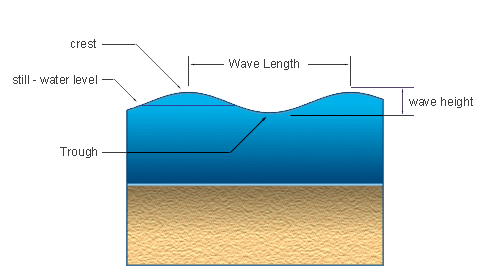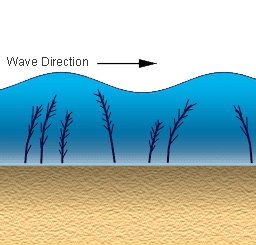PULSE
Learn About Waves
One of the special attractions of oceanic beaches is the rhythmic pounding of the waves, which are almost mesmerizing. I can sit on a beach for hours enjoying the sheer power of these waves as they give up their energy in spectacular displays upon breaking. Our concerns and problems seem to flow out with the tide as the wave action can be so soothing, restoring our spirit. Other people love to play in the waves, taking advantage of their power. But we need to know how to recognize the danger signs, such as shorebreak and rip currents (see Beach Safety).
Waves are undulating forms that move along the surface of the ocean. Waves are primarily caused by the wind blowing across the water; they range in size from ripples caused by a gentle breeze to giant sea waves caused by hurricane-force winds. But all waves are similar regardless of their size and can be described as follows:
Crest-the high point of a wave
Trough-low point of a wave
Wave height-vertical distance from trough to crest
Wavelength-horizontal distance between adjacent crests
Wave period-time in seconds for two adjacent wave crests to pass a fixed point
Waves cause an oscillatory motion of the water, but no real forward movement of the water itself until they come close to shore and break. On a calm day with no breeze, a stick thrown in the water will move up and down as the waves pass, but it will stay in the same location. This phenomena of wave motion is best illustrated by swaying seaweed caused by passing waves, which is indicative of the circular movement of the water particles.
When waves move into shallow water, this circular motion of the water particles cannot be maintained because of friction between the moving water and the sea bottom. Friction causes the lower part of the circular orbit of the wave to slow down relative to the upper part of the wave exposed to the air. Finally, the orbit cannot be closed, and the top of the wave plunges forward, causing breaking; the forward movement of the water is called swash as it rushes up the beach face. Wave movement in shallow water also causes the sand to move, which is apparent from the turbid (sand-filled) water in the breaker zone.
The speed of a wave is determined by the wavelength in deep water. The longer the wavelength, the faster the wave moves. Experienced sailors of yesteryears knew when a hurricane was approaching because of the arrival of the big swell waves. In shallow water where the waves are “feeling” bottom (e.g., friction between the wave motion and sea bottom is occurring), the speed of the wave is controlled solely by the water depth. Therefore, waves slow down as the move into shallower water until they are forced to break.
Waves are always changing the sea surface and the beach as they break onshore. Plunging breakers are the most spectacular as these waves fall forward trapping a cone of air that is compressed until it literally explodes. Large swell waves that encounter a reef or sand bar offshore become a surfer’s delight as they break suddenly in a dramatic fashion. Plunging breakers are most common along the Pacific coast, giving rise to the surfing tradition in Southern California and Hawaii, especially the North Shore of Oahu. Spilling breakers are the most common along the U. S. East Coast; waves break over a long distance as the water become gradually shallower. These waves are far less dangerous and can give some good boogie boarding when the surf is really rolling ashore. Collapsing and surging breakers are much less common with the latter being restricted to very steep beaches, particularly rocky/pebbly (shingle) beaches in England.
Waves provide both the inner peace that comes with the quiet contemplation of gentle breakers rolling ashore on a calm day to the wild exhilaration of riding a big wave ashore on a long board or by body surfing. Waves and beaches are forever changing, which erases our footsteps in the sand while also cleansing our souls. And so it will always be–go and enjoy.


